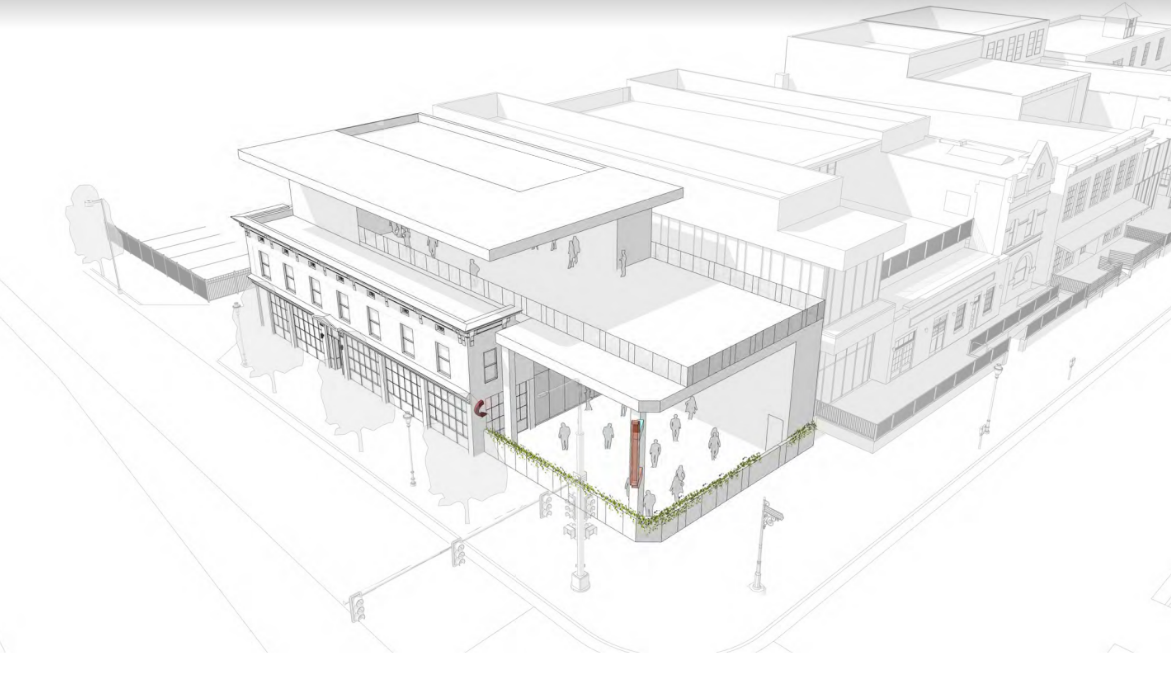
The sun sets on the outside of El Chapultepec on Dec. 7, 2020 in Denver. (Helen H. Richardson, The Denver Post)
Late last year, two years after buying the LoDo building that once housed the El Chapultepec jazz club, Denver developer Kenneth Monfort came to a new conclusion.
It needed to be demolished.
“We originally were saving the building and, after that, saving part of the building and we were rebuilding the building,” he said.

Kenneth Monfort speaks during a September 2023 BusinessDen’s event. (Alyson McClaran/Special to BusinessDen)
The head of Monfort Cos. said the building is unsafe due to its age and, critically, unpermitted work done to it by a local nightclub owner after the jazz club closed in 2020, ending an 87-year run.
Monfort plans to turn the lot at the corner of 20th and Market into a covered patio, which will be part of a new venue incorporating the building next door.
“We would not have considered this design, which happens to be the best design, had none of this happened,” Monfort said.
But there’s already pushback. On Tuesday, the preservation-minded nonprofit Historic Denver announced it would lead a push to name the structure a city landmark, effectively preventing demolition.
A jazz club, a nightclub owner and a Rockies heir
El Chapultepec opened the day after Prohibition ended in 1933, and over the decades became a Denver institution, hosting local and touring jazz musicians. But owners Anna Diaz and Angela Guerrero closed for good in late 2020.
While the pandemic was still in full force then, Diaz told BusinessDen the establishment had weathered downturns before and could have done so again. The real problem was that the area had changed.
“We just didn’t feel safe there,” she said. “The let-out scene didn’t match the Pec. The type of client we catered to did not want to come down there.”
After the club closed, Evan Makovsky, the building’s owner at the time, originally leased the property to Hussam Kayali, who goes by Valentes Corleons. Corleons owned the nearby Beta nightclub, and planned to turn the space into a new concept called Cantina.
But the self-proclaimed “king of nightclubs” ran into trouble. The city began investigating after a shooting outside Beta and a jump in 911 calls nearby. In early 2022, the nightclub was stripped of its liquor and cabaret licenses, forcing its closure. A city official said Corleons had tried to bribe a police officer. Not long after, he told Westword he’d given the keys for the El Chapultepec space back to his landlord. Cantina had never opened.
In November of that year, Makovsky sold the property to Monfort, who paid $5.4 million for it and the adjacent 1320 20th St. building used by the sports bar Giggling Grizzly.
It wasn’t a shocking acquisition. Monfort, whose father and uncle are majority owners of the Colorado Rockies, wants to see the area around Coors Field become an entertainment district. By late 2022, he’d already zeroed in on the 1900 block of Market Street. He’d gotten Dierks Bentley’s Whiskey Row up and running in the former LoDo’s Bar & Grill space. Two doors down, he was breaking ground on Riot House, refashioning a building where MTV’s “The Real World” once filmed a season.
The El Chapultepec and Giggling Grizzly buildings would allow for a third project on the block.
“We won’t do anything to erase El Chapultepec out of the history books,” he said the day he closed on the purchase. “In fact, we’re going to embrace the history that place had in Denver.”

A drawing showing Monfort Cos.’ proposal for the El Chapultepec and Giggling Grizzly buildings. (Public records)
‘A building that cannot be repaired’
In an interview last week, Monfort told BusinessDen that, when he bought the El Chapultepec building, he knew Corleons had done work to the building that hadn’t been permitted. The city had discovered it, he said, when Corleons was trying to get a liquor license.
“We did not know what the result of that unpermitted work was, which was an unsafe building,” Monfort said.
Matt Runyon, development partner at Monfort Cos., said the work included removing load-bearing walls. The ramifications of that became clear when the firm brought in engineers.
“There had been noticeable degradation to the building, but what was most alarming was that some of this was new, and they knew this because breaks in trusses, for instance, showed no dust,” Runyon said. “In a building this old, if there was a crack and it wasn’t new, it would have had dust in it.”
“This is a building that cannot be repaired,” Runyon added.
In a November report provided to BusinessDen, HCDA Engineering — one of two firms hired by Monfort Cos. to assess the building’s condition — wrote that the following components of the structure “will require complete reconstruction”: significant portions of the exterior walls, the entire roof framing area, the majority of the second floor framing and the entire existing main floor.
The assessment prompted a change in what had been the firm’s approach to redevelopment.
“We understood that the desire would be to try to keep the building, so our early desires certainly kept that in mind,” Runyon said.
The plan now is to renovate the Giggling Grizzly building, where Runyon said the second floor has long been unusable. A rooftop deck will be added and extend into the air space above where El Chapultepec sits. That structure will be demolished and turned into a patio. A stairway at the rear of the El Chapultepec lot will lead up to the roof deck.
The El Chapultepec sign will remain close to where it is now, attached to a beam holding up the roof deck.
“The cultural significance that was El Chap was on the inside, meaning that we’re just exposing that,” Monfort said. “And what we plan to do inside this patio … we still have a ton of opportunity to honor that legacy.”
Monfort said he expects the project to cost another $15 million or so on top of the purchase price.
The firm submitted plans this week to the Lower Downtown Design Review Commission. The Giggling Grizzly building is a “contributing structure” to the LoDo Historic District, meaning it was considered to have historical significance when the district was established in 1988. The El Chapultepec building, which dates to 1886, is not.
Circle West Architects is behind the design of the redevelopment.
“It’s rinse and repeat here in the city a lot of times, and I think this offers a nice breath of fresh air, as it were,” Runyon said. “We wouldn’t have seen that were it not for this path that we’ve taken.”
Monfort said he sees bringing activity to the corner as critical for a part of town that has sometimes seen violence erupt. Five people were shot outside Whiskey Row in September. Monfort said he feels there’s been progress amid ongoing talks with Denver Police.

A drawing showing Monfort Cos.’ proposal for the El Chapultepec and Giggling Grizzly buildings. (Public records)
Monfort: ‘Jazz has a new home in Denver’
Diaz, the El Chapultepec co-owner, said the pending demolition is “disappointing,” but “certainly understandable” given the condition of the building.
Last year, Diaz and Guerrero established the “El Chapultepec Legacy Project,” which seeks to keep the venue’s spirit alive. More a passion project than a business — Diaz is setting it up so she can take donations and get grants — the project includes hosting a jazz set on Thursday through Saturday evenings at Dazzle within the Denver Performing Arts Center. She’d like to expand that.
“The magic of El Chapultepec was really in the people … and all those people are still in the jazz community,” Diaz said.
Monfort said exactly what type of concept will eventually open at the site is “still in a very malleable form.” He indicated that it might target a different audience than Whiskey Row and Riot House do.
“Our intent here is to round out the block in a way that doesn’t just add another nightclub, or a superbar, as I call them,” Monfort said.
Monfort said he’s considering a Hollywood Walk of Fame-style display within the patio, showcasing the recognizable names that once played El Chapultepec. He’s open to “anything that’s complementary to honoring that legacy from a programming perspective.”
But don’t expect the venue to go all in on jazz.
“There is a reason that the Pec no longer exists … Cities’ tastes evolve, and that’s what happened,” Runyon said.
“Jazz has a new home in Denver,” Monfort said. “And that is Dazzle.”
The nonprofit Historic Denver said Tuesday that it had submitted a landmark designation application for the structure in conjunction with professional musician Ron Bland and former City Council member Elbra Wedgeworth. CEO John Deffenbaugh said he wants to reach a compromise with Monfort.
“We oppose demolition of the building,” Deffenbaugh said. “Full stop.”
Deffenbaugh said he met with Monfort in December, and hoped it would be a conversation about how the groups could work together to incorporate the existing structure into a new project. Instead, “I was presented with a pretty much fully formed design proposal.”
Deffenbaugh said he hasn’t seen any of the reports about the building’s condition.
“It’s an old building,” he said. “It’s going to have deficiencies. That is what contemporary repair and restoration techniques are for … This is one of the most culturally significant buildings in Lower Downtown.
“The joy of an old building is knowing that you’re walking through a door … that Bill Clinton walked through, or a famed musician.”
Whether to name the building a landmark will likely ultimately be up to the Denver City Council unless Monfort changes his plans. He called the submission of the landmark designation application “a complete surprise,” saying he had been talking to the organization along with others that might have an interest in the site.
“We understand on the surface that the removal of the building is a complicated matter, but we’re doing everything we can to resolve concerns around that and continue the legacy while we can while doing profitable development on the block,” he said.
